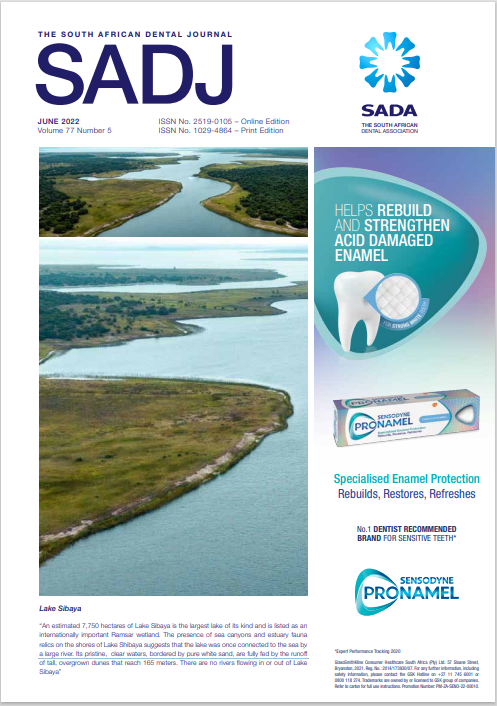An evidence-based guide to occlusion and articulation. Part 5: New roots: titanium and its influence on occlusion; and to cusp or not to cusp?
DOI:
https://doi.org/10.17159/2519-0105/2022/v77no5a4Keywords:
periodontal ligamentAbstract
Although this is essentially a review, it has not been written in the passive, third-person style normally associated with scientific writing, as it is intended to be thought-provoking and, hopefully, educational. It has therefore been written in more of a conversational style,
and is aimed at students, dentists and dental technicians who are receptive to a slightly different view of occlusion and articulation, based on evidence. Occlusion is a topic that has become a kind of archaic minefield of conflicting ideas, propositions, and above all,
solutions, most of which are based on a complete lack of understanding of the evolution and development of teeth, and by extension, of clinically objective evidence.
Downloads
References
Brånemark PI, Hansson BO, Adell R, Breine U, Lindström J, Hallén O, et al. Osseointegrated implants in the treatment of the edentulous jaw. Experience from a 10- year period. Scand J Plast Reconstr Surg Suppl. 1977; 16: 1-132.
Zarb GA. Implantomania: prosthodontics at a crossroads. Int J Prosthodont. 2012; 25(2): 180-5.
Lindhe J, Pacey L. 'There is an overuse of implants in the world and an underuse of teeth as targets for treatment' Br Dent J. 2014; 217(8): 396-7. doi: 10.1038/ sj.bdj.2014.930.
Giannobile WV, Lang NP. J Are Dental Implants a Panacea or Should We Better Strive to Save Teeth? J Dent Res. 2016; 95(1): 5-6
Zarb GA, Hobkirk JA. On Implant Prosthodontics: One Narrative, Twelve Voices – Introduction. Int J Prosthodont. 2018; 31 Suppl: s6-s8. doi: 10.11607/ijp.2018.suppl.e.
Lang NP, Müller F, Working Group I. Epidemiology and oral function associated with tooth loss and prosthetic dental restorations. Consensus report of Working Group I. Clin Oral Implants Res 2007; 18 Suppl 3: 46–9 doi: 10.1111/j.1600-0501.2007.01437.x.
Goodacre BJ, Goodacre SE, Goodacre CJ. Prosthetic complications with implant prostheses (2001-2017). Eur J Oral Implantol. 2018; 11 Suppl 1: S27-S36.
Pieralli S, Kohal RJ, Rabel K, von Stein-Lausnitz M, Vach K, Spies BC. Clinical outcomes of partial and full-arch all-ceramic implant-supported fixed dental prostheses. A systematic review and meta-analysis. Clin Oral Implants Res. 2018; 29 Suppl 18: 224-236. doi: 10.1111/clr.13345.
Papaspyridakos P, Bordin TB, Natto ZS, El-Rafie K, Pagni SE, Chochlidakis K, et al Complications and survival rates of 55 metal-ceramic implant-supported fixed complete-arch prostheses: A cohort study with mean 5-year follow-up. J Prosthet Dent. 2019; 122(5): 441-449. doi: 0.1016/j.prosdent.2019.01.022.
Papaspyridakos P, Bordin TB, Kim YJ, El-Rafie K, Pagni SE, Natto ZS et al. Technical Complications and Prosthesis Survival Rates with Implant-Supported Fixed Complete Dental Prostheses: A Retrospective Study with 1- to 12-Year Follow-Up. J Prosthodont. 2020;
(1): 3-11. doi: 10.1111/jopr.13119.
Abarca M, Van Steenberghe D, Malevez C, Jacobs R. The neurophysiology of osseointegrated oral implants. A clinically underestimated aspect. J Oral Rehabil 2006; 33: 161–9. doi: 10.1111/j.1365-2842.2005.01556.x.
Kim Y, Oh T-J, Misch CE, Wang H-L. Occlusal considerations in implant therapy: clinical guidelines with biomechanical rationale. Clin Oral Implants Res. 2005; 16(1): 26-35. doi: 10.1111/j.1600-0501.2004.01067.x.
Weinberg LA. The biomechanics of force distribution in implant-supported prostheses. Int J Oral Maxillofac
Implants 1993; 8(1): 19-31.
Weinberg LA. Therapeutic biomechanics concepts and clinical procedures to reduce implant loading. Part I. J Oral Implantol. 2001; 27(6): 293-301. doi: 10.1563/15481336(2001)027<0293:TBCACP>2.3.CO;2.
Sornsuwan T, Swain MV. Influence of occlusal geometry on ceramic crown fracture; role of cusp angle and fissure radius. J Mech Behav Biomed Mater. 2011; 4(7): 1057-66. doi: 10.1016/j.jmbbm.2011.03.014
Wan B, Shahmoradi M, Zhang Z, Shibata Y, Sarrafpour B, Swain M, et al. Modelling of stress distribution and fracture in dental occlusal fissures. Sci Rep. 2019; 9(1): 4682. doi: 10.1038/s41598-019-41304-z.
Shahmoradi M, Wan B, Zhang Z, Wilson T, Swain M, Li Q. Monolithic crowns fracture analysis: The effect of material properties, cusp angle and crown thickness. Dent Mater. 2020; 36(8): 1038-1051. doi: 10.1016/j.dental.2020.04.022.
Palamara D, Palamara JE, Tyas MJ, Messer HH.Strain patterns in cervical enamel of teeth subjected to occlusal loading. Dent Mater. 2000; 16(6): 412-9. doi: 10.1016/s0109-5641(00)00036-1.
Kuroe T, Itoh H, Caputo AA, Konuma M. Biomechanics of cervical tooth structure lesions and their restoration. Quintessence Int. 2000; 31(4): 267-74.
Benazzi S, Nguyen HN, Kullmer O, Hublin J. Unravelling the Functional Biomechanics of Dental Features and Tooth Wear. PLoS ONE 2013; 8(7): e69990. doi:10.1371/journal.pone.0069990
Downloads
Published
Issue
Section
License

This work is licensed under a Creative Commons Attribution-NonCommercial 4.0 International License.





.png)